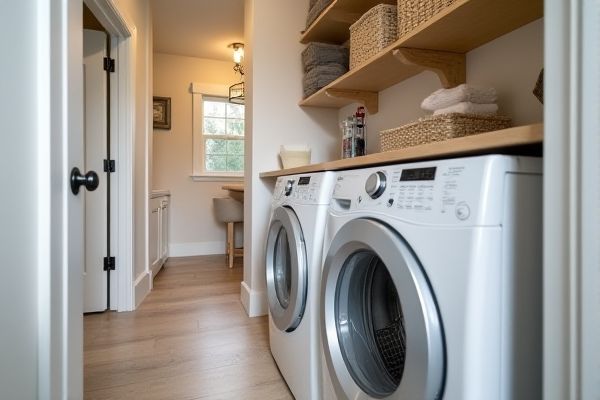
Closet-style laundry offers a concealed space that minimizes noise and keeps clutter out of sight, while an open laundry nook provides easy access and can be integrated seamlessly into your living area for convenience. Discover which laundry setup best suits Your home's style and functionality in the rest of this article.
Table of Comparison
| Feature | Closet-Style Laundry | Open Laundry Nook |
|---|---|---|
| Space Utilization | Compact, hides appliances when not in use | Uses open space, integrates with room design |
| Noise Control | Better noise reduction with doors | More noise exposure, less sound insulation |
| Accessibility | Requires opening doors to access | Immediate access, no barriers |
| Ventilation | Limited, may require additional ventilation | Better air circulation |
| Aesthetics | Clean, concealed look | Visible appliances, can be styled decoratively |
| Installation Cost | Moderate, includes door and enclosure | Lower, minimal enclosure required |
| Maintenance | More effort to clean inside closet | Easier cleaning due to openness |
Introduction to Laundry Space Designs
Closet-style laundry spaces maximize efficiency by concealing appliances and storage behind doors, creating a tidy environment ideal for compact homes. Open laundry nooks offer seamless accessibility and better ventilation, enhancing usability in larger or multi-purpose areas. Choosing your laundry space design depends on balancing aesthetics, space constraints, and functional needs.
What is a Closet-Style Laundry?
A closet-style laundry is a compact, enclosed space designed to house laundry appliances such as washers and dryers, often fitted with bifold or sliding doors to conceal them when not in use. This setup maximizes space efficiency in homes with limited square footage while maintaining a tidy, organized appearance. Closet-style laundry areas typically include shelves or cabinets for storage, enhancing functionality without sacrificing aesthetic appeal.
Defining an Open Laundry Nook
An open laundry nook is a designated laundry area integrated seamlessly within a room, typically lacking doors or full enclosure, allowing for easy access and natural airflow. Unlike closet-style laundry spaces that confine appliances behind doors, open nooks promote efficient use of space and contribute to the overall room aesthetic. Your choice between these setups depends on space availability, design preferences, and noise considerations.
Space and Layout Considerations
Closet-style laundry units maximize compact spaces by enclosing washer and dryer appliances, promoting a tidy appearance and reducing noise, ideal for small apartments or narrow corridors. Open laundry nooks offer greater flexibility in layout, providing room for additional storage or folding surfaces, and improve ventilation, which is beneficial in larger or multi-purpose areas. Selecting between these options depends on available square footage and desired workflow efficiency within the home's overall floorplan.
Aesthetic Appeal: Concealed vs Exposed
Closet-style laundry areas provide a sleek, concealed look that seamlessly blends into surrounding cabinetry, enhancing a home's clean and organized aesthetic. Open laundry nooks expose appliances and storage, offering a more casual, accessible vibe but requiring meticulous organization to maintain visual appeal. Homeowners prioritizing a polished, minimalistic design often prefer closet-style laundry for its ability to hide clutter and maintain consistent decor.
Noise and Privacy Factors
Closet-style laundry rooms provide superior noise insulation and enhanced privacy by enclosing washers and dryers behind doors, effectively minimizing sound disruption throughout your home. Open laundry nooks, while offering easy access and space-saving benefits, tend to allow more noise to travel and expose your laundry area to household visibility. Your choice depends on your preference for a quieter environment and desire for a discreet laundry setup.
Ventilation and Moisture Control
Closet-style laundry spaces require superior ventilation systems to prevent moisture buildup and mold growth due to their enclosed nature. Open laundry nooks benefit from natural airflow, reducing humidity and promoting faster drying times. To protect Your laundry area, ensure proper exhaust fans or vents are installed, especially in closet-style setups to maintain optimal moisture control.
Storage Solutions and Organization
Closet-style laundry spaces offer enclosed storage solutions that keep detergents, cleaning supplies, and laundry essentials neatly hidden, reducing clutter and promoting a tidy appearance. Open laundry nooks prioritize accessibility with visible shelving and baskets, allowing you to quickly reach detergents and organize items based on frequency of use. Your choice impacts how efficiently you can arrange laundry tools and maintain order, balancing aesthetics with functionality in your laundry area.
Maintenance and Cleaning Ease
Closet-style laundries offer enclosed spaces that reduce dust accumulation and keep appliances protected, making maintenance tasks like wiping surfaces and cleaning filters more straightforward. Open laundry nooks allow for better ventilation which helps prevent mold and mildew, though they may require more frequent dusting and floor cleaning due to exposure. Selecting a design impacts the frequency and ease of cleaning chores, with closet-style spaces generally minimizing visible clutter and maintenance efforts.
Which Laundry Style Suits Your Home?
Closet-style laundry efficiently conceals appliances and supplies within a dedicated space, ideal for homes prioritizing aesthetics and noise reduction. Open laundry nooks offer accessibility and integration into living areas, enhancing convenience in smaller homes or apartments. Choosing the right style depends on your home's layout, storage needs, and preference for visibility versus hidden functionality.
 homyna.com
homyna.com